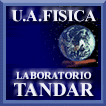|
The singular dynamical properties of nanoparticles must be characterized over wide time scales, six
to eight decades at least, this is generally achieved by using a variety of techniques as
zero-field-cooling magnetization measurements (MZFC) with t=102 sec and
Fe57 Moessbauer spectroscopy (MS) with t=10-8
sec resulting from the nuclear Larmor precession time.
Compared to other techniques, MS shows a few distinctive advantages since the measurements present
a superposition of local effects instead of an average, on the other hand the time scale is rather
short but long enough to allow the observation of the transition from the blocked to the
superparamagnetic state in a convenient temperature range. Both states are easily recognized in a
Moessbauer spectra. Furthermore, small variations in the properties often manifest themselves as
noticeable effects in the spectra and are evidenced through the evolution of the hiperfine
parameters with temperature.
Antiferromagnetic ultra-fine particles possess a rather low magnetic moment attributed to a
non-exact compensation of the two magnetic sublattices, originating both from the bulk through the
presence of structural defects and/or distortions, and from the surface through the canted magnetic
arrangement due to surface anisotropy. The relaxation time of antiferromagnetic particles is about
two orders of magnitude lower that those of ferromagnetic and ferrimagnetic particles, leading to a
very sharp sextet-to doublet transition.
Moessbauer studies on nanohematites of different sizes (about 5nm and 30 nm) are presented. The
effect of the particle interactions are particularly examined in the smaller sized nanohematites
while in the larger ones, the effects of thermal treatment are inspected, both through the
behaviours of the Morin temperatures, of the parameters of the weakly ferromagnetic and
antiferromagnetic phases and of the superparamagnetism. Moessbauer results reveal a larger magnetic
exchange couplings for smaller interparticle distances (smaller-sized particles) and also reveal
the influence of the cystallinity on the magnetic properties (larger particles).
|
